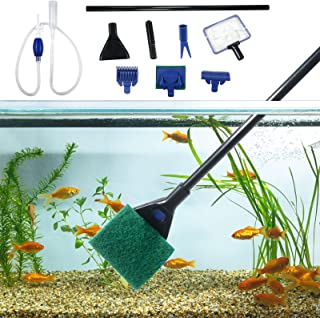You usually don’t have to remove fish from the aquarium when cleaning it. There are gravel vacuum, siphons, scrubbers, and scrapers available at most pet stores and online that allow you to remove waste/algae from the tank while hardly disturbing any tank occupants.
Main Principles of Aquarium Cleaning
You should be replacing some of the water in your tank with fresh, clean water treated with a water conditioner once every week or two. This will help to remove ammonia-producing waste and food remains, as well as old, unclean water. An aquarium siphon can help you to “vacuum” the substrate and remove these items from your tank. The safest way to clean your fish tank is by slowly replacing the water bit-by-bit. 10-20% weekly or biweekly should do it. If you were to dump all of the water and start from scratch, you would risk shocking your fish with unfamiliar chemicals. And if you neglect cleaning altogether, ammonia and nitrate will build up over time and eventually kill your pets.
If the situation is dire–i.e., the tank is teeming with algae–you can catch your fish using a net or cup while you clean out their home completely.”
What To Start From?
Today we are going to show you how to use this weapon which is the gravel vacuum. There are many budget options for aquarium vacuum cleaners, Aqueon Siphon Vacuum Aquarium Gravel Cleaner, is one of the simplest.
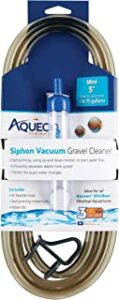
Some of them are sold in whole sets that include additional tools such as microfibre, gloves or an extra brush, for example, bedee Electric Aquarium Gravel Cleaner Vacuum Kit.
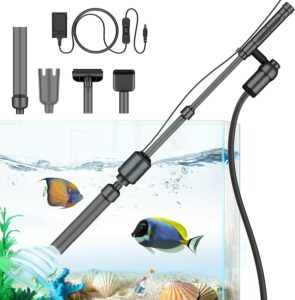
For what it’s worth, this thing is amazing because it’s actually a piece of hose. What I’m going to tell you is how to start it without sucking up the end and without doing anything crazy like making sure we get the waste out of the gravel and not mixing it in, and how to do it on a low tank. So maybe you have 10 gallons or something very close to the bottom, how do we do this? So for the top tank, I’m going to use this Krollen Industrial 35 Gallon Grey Square Commercial Trash Can. I recommend a really big bucket, kind of like one of those laundry totes or something like that or maybe a tote from Home Depot. A bucket, you can be ding around cleaning, and all of a sudden, you’re flooding your floor without realizing. And this is a whole 35 or 55 gallons.
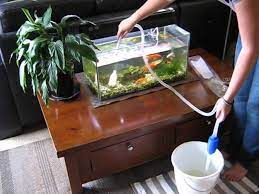
Let’s start from some basic principles. Water is going to flow down a pipe. This end of it has to be lower than this end of it. So we put that in the bucket. The trick is here, we need the water to come out of the tank down the pipe. If you just put in like this, it doesn’t do anything because right here it’s got all this air, it doesn’t do anything. You can put all the way down. It doesn’t do anything. I will show you a trick that works but is stupid and don’t do this because it takes too much time. You can put the entire dirty hose that you have in your aquarium. If you’ve got a planet tank and all of that, this is not the best thing but you can get all the air out of your hose. Now you put your thumb on the end of the hose, here you go on.
How To Fill The Tube And The Hose?
Now we have a tube filled with water. Mostly, if we put it in our bucket, now it flows, magic, right? Well, let’s not ruin our aquarium to do it this time. The goal is that we need to fill the tube and hose with water without letting any air in. You angle it, you drop it down, and right now it’s still full of air because that tip hasn’t gone below the water. If I move it up, the water that’s here will go down here. Everything went downhill and then we ran out; it hit the air so it stopped.

So we put it down and we’re filled. Now what’s going to happen? I’m going to lift it up and once the water, once it starts flowing, I’m going to put it back down. Water’s flowing, goes back down. We put it ban down in, just like that and there’s no air. Then we lift it up. Once the water starts going, we put it back down in.
Cleaning The Inside
Now we’re going to drain our aquarium. Pinch your hose to be able to have control. So even though there’s no water flowing right now. And then, we’re ready to start again – got your water flowing and put it into the bottom. If I don’t stop it, now it’s sucking up gravel. Look at the gravel going, that’s not good, too much dust is floating around. So your goal is when the waste separates. Because it should be pinched and nothing should be moving. You can actually throttle and get it super clean and not take out a lot of water of your aquarium.
A lot of people run out of water. If you never pinch, you’re going to run out of water on that 10-gallon tank. You got to pinch when you move it. So then we move it back, we open it up, we start separating. It’s now separated. We can actually now move it on. You see how much we can basically get it so that it’s always going to be super brown water. See, there’s a separation we wanted. So I highly recommend we go into a corner, we start one corner. It’s like you’re mowing a lawn. Start cleaning it, start cleaning it. Now we’re clean. Keep it pinched, move it back, keep going. And we’re just going to make rows.
So you can see how you end up with little piles. Kind of like when you’re mowing a lawn, you get lines from mowing your lawn and now you can know, by the way, these are the easy planters and you can see that the roots were in the substrate. So they go through the bottom and it was in there and now I can move it again. And right where it was, waste always settles really thick under decorations. So you always want to move decorations when you’re doing it. And you keep moving.
Video: How to Use a Gravel Vac to Vacuum Your Aquarium
Cleaning Between The Fish
Here’s my last tip, don’t miss it. When you remove this from your aquarium, put your hand at the end of it. We’ve done water changes and clean sponges and that kind of stuff before. I’ve got to put this in here and I’ve got to have the presence of mind to not overfill it. So the container has to be lower than your aquarium. Now, this aquarium has been neglected for a reason. The fish that are in here are very rare.
Now we’re going to do the same tactic to get this started. You got to go a little bit slower a lot of times. So we fill it up with the water, it won’t go as fast. You see how it’s going to going slower, you got more time to react. So you could just normally gravel-vac like normal. So we’re going to come down here and we’re going to suck up a bunch of sand. With sand typically, waste settles on the top. So if I come over here and I gravel-vac, this tank has been not gravel-vac much longer than the one we just did, but not that much comes off of it. The sand itself is pretty clean, and so a lot of times you kind of just vacuum the top. You see how it cleans itself up.
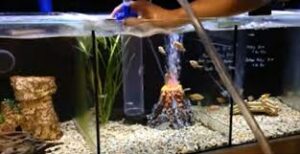
Cleaning The Sand
Yeah, if you have a sand aquarium, you don’t need to go very deep at all. Just that top, maybe quarter inch or so, maybe you got decor. You want to clean that up a little bit. Now we haven’t been vacuuming that long. Can we agree on that? We have a half a bucket full already. It’s real easy to forget. So don’t forget you don’t want to ruin your carpet. You don’t want your spouse ruining you after you ruin the carpet. Let’s say I’m not going to clean that sponge filter today. You can vacuum it. You can push into a sponge filter and vacuum it. You see that, if I push into the side, ah, looks like safe. The goal of the planet tank is fish poop and mulm and that kind of stuff, broken down material is useful for rooted plants. So things like the crypto corns really thrive with gunk in the substrate.
Cleaning Between The Plants
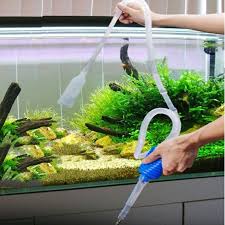
I’m going to pinch it. You’ve got two plants right here. Usually, a plant will have about a six-inch radius around it where it’s pulling nutrients from. So I’m going to show you how dirty this aquarium is. So all that poop in there is food for that plant. So it comes all the way over to here, all those little hairs, the little roots, these little ones are actually what feed and they’re called tap roots. Okay. Now I’ll have to replant this later. But you can see all this gunk is what they want to be eating in addition to root taps and things like that. Just want to get the top layer. So now we have this plant here that I have not disturbed, but I’ve got gunk in there that I don’t necessarily want. You want to get just the little top layer.
So you might go, “Okay, I’m going to go like a quarter inch and just remove that top layer of sludge,” and you do it right here. So that way you’re not breaking any of the roots. You go in between the plants just like I’m doing and you kind of just keep working your way through. And that is how you do sand, how you do planet tanks, how you do tall tanks, short tanks, and how you keep an eye on your bucket because if I go too much longer, I got poopy water on the floor, and nobody likes that.
